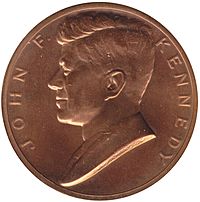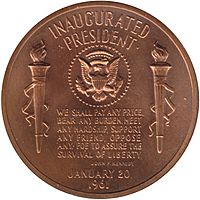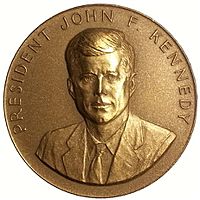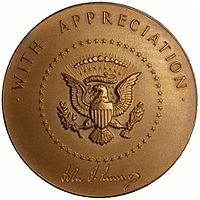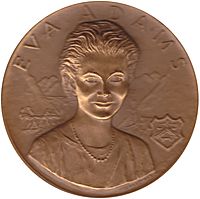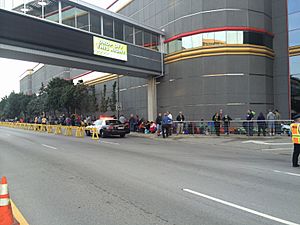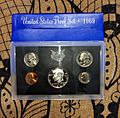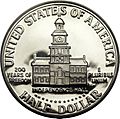Kennedy half dollar facts for kids
| United States | |
| Value | 50 cents (.50 US dollar) |
|---|---|
| Mass | Copper-nickel clad: 11.34 g 40% silver clad: 11.50 g |
| Diameter | 30.6 mm |
| Thickness | 2.15 mm |
| Edge | reeded |
| Composition |
|
| Gold | (2014 commemorative) .75 troy oz |
| Silver | Circulation strikes since 1971 contain no silver. For 90% silver issues: 0.36169 troy ounces. For 40% silver issues: 0.1479 troy oz |
| Years of minting | 1964–present |
| Mint marks | P, D, S, W. "W" mint mark only on 2014 commemorative issue. Mint mark located beneath where the eagle's claws grasp the olive branch on reverse for 1964 coins and for 1964-2014-W gold issue; above the date on the obverse for all other issues. Mint mark omitted on all coins from 1965 to 1967 and on Philadelphia Mint issues before 1980. |
| Obverse | |
 |
|
| Design | Left profile of John F. Kennedy |
| Designer | Gilroy Roberts |
| Design date | 1964 to present |
| Reverse | |
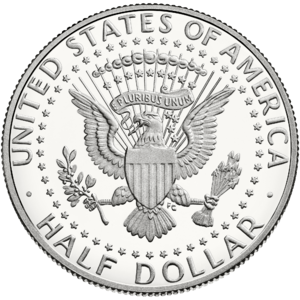 |
|
| Design | Modified presidential seal |
| Designer | Frank Gasparro |
| Design date | 1964 to present, excepting 1975 and 1976 |
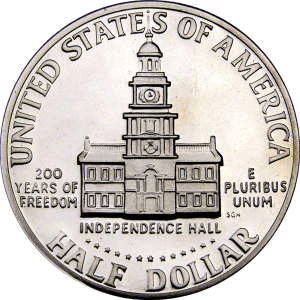 |
|
| Design | Independence Hall |
| Designer | Seth G. Huntington |
| Design date | 1975 and 1976 (dated 1776–1976) |
The Kennedy half dollar is a fifty-cent coin made by the United States Mint. It was first made in 1964. This coin was created to honor John F. Kennedy, who was the 35th President of the United States. He was assassinated in November 1963. Congress approved the coin just over a month after his death.
Mint artists Gilroy Roberts and Frank Gasparro used their existing designs of Kennedy. This helped them make the coin molds quickly. The new coins started being made in January 1964. When the silver coins were released in March 1964, people quickly collected them. Many wanted a souvenir of the late president.
Even though the Mint made many more coins, the half dollar was rarely seen in everyday use. The price of silver kept going up. This made people save the coins even more. Many early Kennedy half dollars were melted down for their silver. From 1965, the amount of silver was cut from 90% to 40%. But the coin still did not circulate much.
In 1971, silver was completely removed from the coins. Production increased, but the half dollar was still not used much. A special design for the back of the coin was made for the United States Bicentennial. These were made in 1975 and 1976. Special collector coins were also made for the Bicentennial. These included silver-clad versions. In 1992, special proof sets began to be made. These sets had the dime, quarter, and half dollar made from 90% silver. In 2014, a special 50th anniversary Kennedy half dollar was made from 99.99% gold.
Even today, you can get half dollars from most banks. However, they are still not used much in daily life. Since 2002, Kennedy half dollars have mostly been made for collectors. You can buy them from the Mint for a higher price than their face value.
Contents
How the Kennedy Half Dollar Was Created
Just hours after President Kennedy's assassination in November 1963, the Mint Director, Eva Adams, called the Chief Engraver, Gilroy Roberts. She told him that they were thinking about putting Kennedy's picture on a large silver coin. This could be the silver dollar, half dollar, or quarter dollar.
On November 27, Adams told Roberts to start the project. Kennedy's widow, Jacqueline Kennedy Onassis, preferred that he be on the half dollar. This would replace the old design of Benjamin Franklin. Mrs. Kennedy did not want to replace George Washington on the quarter.
To save time, Roberts changed a Kennedy design he had already made for a medal. Frank Gasparro also changed a design he had made for the back of the same medal. Both Roberts' and Gasparro's designs had been approved by Kennedy before his death. Roberts had even met Kennedy to show him early models.
After the Mint made some test coins, Jacqueline and Robert F. Kennedy saw them. Mrs. Kennedy liked the designs. She suggested a small change to the hair. Some people also suggested using a full or half picture of the president. But Roberts said there was not enough time for a completely new design. He also thought the left side of Kennedy's face would look best.
Frank Gasparro's design for the back of the Kennedy half dollar was also based on his experience. He had designed the President John F. Kennedy appreciation medal in 1962. President Kennedy had 300 of these medals made. He gave them out during his trip to Europe in 1963.
The back design of the appreciation medal shows a larger and more detailed Presidential Seal. This is similar to the one on the half dollar. Gasparro's initials "FG" are also in a similar spot. They are under the eagle's right leg on both the medal and the half dollar.
Congress had to approve any design change within 25 years. In early December, Representative Henry B. González introduced a bill. This bill was to put Kennedy on the half dollar. On December 10, the new President, Lyndon B. Johnson, supported the idea. He asked Congress to pass the law quickly. This would allow the new coins to be made early in 1964.
President Johnson said he had received many letters from people who wanted the coin. The bill to allow the Kennedy half dollar passed on December 30, 1963. Work on the coin molds was already happening. Using the existing designs helped finish the first molds by January 2, 1964.
Only proof coins were made at first. The first Kennedy half dollars for general use were made at the Denver Mint on January 30, 1964. The Philadelphia Mint started making them the next week. A special first strike ceremony happened at both Philadelphia and Denver on February 11, 1964.
The Coin's Release
The Treasury Department started selling the coins to the public on March 24, 1964. A very long line formed at the department's windows in Washington. People wanted to buy the 70,000 coins set aside for public sale. The department limited sales to 40 coins per person. But by the end of the day, all the coins were gone. The line was still long.
Banks in Boston and Philadelphia quickly ran out of coins. Sales in New York started the next day. They also had to limit how many coins each person could buy. This made some coin dealers unhappy.
The coins were popular in other countries too. U.S. Assistant Secretary of State for African Affairs G. Mennen Williams gave them to leaders in African nations. He hoped it would help make friends for the United States. Soon after the coin came out, the Denver Mint got complaints. Some people thought the coin showed a hammer and sickle on Kennedy's neck. Roberts explained that it was actually his own initials, a stylized "GR".
The Mint made many Kennedy half dollars to meet the huge demand. The Treasury first planned to make 91 million half dollars for 1964. Then they increased it to 141 million. But even with more coins, they did not circulate much. Prices for the coins in the market did not go down. By late November, about 160 million coins had been made. Still, the coin was almost never seen in daily use.
The price of silver was going up. Most of the coins were being saved by people. The Treasury hoped that making more 1964-dated coins would stop people from hoarding them. Congress allowed them to keep making 1964-dated coins into 1965. In the end, almost 430 million half dollars dated 1964 were made. This was more than all the Franklin half dollars made in 16 years.
Making so many coins used up a lot of the Treasury's silver. Silver prices were so high that by early June, a dime had 9.33 cents worth of silver in it. On June 3, 1965, President Johnson announced a plan. He wanted to remove silver from the dime and quarter. They would be made of a copper-nickel sandwich instead. The half dollar's silver content was changed from 90% to 40%. Congress passed the Coinage Act of 1965 in July.
The new half dollars still looked silvery. This was because the outer layer was 80% silver and 20% copper. The inner layer was 21% silver and 79% copper. The first new half dollars were made at the Denver Mint on December 30, 1965. They were dated 1965. The date on US coins would not change until the coin shortage ended.
Starting August 1, 1966, the Mint began making 1966-dated coins. After that, they went back to dating coins with the current year. Even though the coin shortage was said to be over, Kennedy half dollars still did not circulate much. This was because people kept hoarding them. Also, fewer were made. The Treasury did not want to use more silver on a coin that was not being used.
Changing to Base Metal
In May 1969, the Treasury wanted to remove all silver from the half dollar. They wanted to make it from the same copper-nickel material as the dime and quarter. They also wanted to make copper-nickel one dollar coins. These would be useful for games in casinos. Former president Dwight D. Eisenhower had recently passed away. There was talk of putting his picture on the new dollar.
The Treasury hoped that without silver, the dollar coin would be used more. President Richard Nixon supported this. But some Republicans in the House of Representatives did not like the idea of Eisenhower on a base metal coin. This argument lasted over a year. Finally, President Nixon signed a bill on December 31, 1970. This bill allowed the Eisenhower dollar to be made. It also removed the last 40% silver from the half dollar.
Because of the delay, in 1970, half dollars were only made at the Denver mint. They were only available in special mint sets. About 2.1 million of the 1970-D Kennedy half dollars were made. This makes it a "key" coin for collectors. To stop people from hoarding these sets, the Mint did not announce this until after orders for the mint sets had closed.
By 1971, when silver was removed, the half dollar had not been seen in circulation for so long. Some banks had even removed the slot for it from their machines. The Mint thought the coin would become popular again. But only a small increase in use was seen after the 1971 coins came out.
In July 1971, Mint Director Mary Brooks said the Treasury had 200 million new half dollars. But banks were not interested in ordering them. Brooks said, "I can't understand the population. They're not using them." She also said that most of the over one billion silver Kennedy half dollars had been saved by the public. Brooks thought that because the silver Kennedy half dollar never circulated much, people were used to not seeing it.
On March 5, 1973, Brooks announced that the Mint would ask for new designs for the half dollar and dollar. These designs would celebrate the 1976 United States Bicentennial. On October 18, President Nixon signed a law for new designs. These designs would be for the quarter, half dollar, and dollar. They would show things from the Bicentennial era.
The Mint held a competition for American sculptors. Seth G. Huntington's design of Independence Hall was chosen for the half dollar. All half dollars made in 1975 and 1976 had the double date 1776–1976 on the front. They had Huntington's design on the back. Over 521 million Bicentennial half dollars were made for circulation.
After the Bicentennial coins, fewer half dollars were made each year. However, in 1979, Mint Director Stella B. Hackel said the Mint would keep making them. "We don't think many half dollars are used in stores. But they go somewhere, so someone must want them." By then, over 2.5 billion Kennedy half dollars had been made since 1964. This was more than all US half dollars made before that time combined.
Some people thought that people were still hoarding the coins, even the base-metal ones. The silver boom of 1979–80 caused many 1964–69 silver Kennedy half dollars to be sold and melted. High silver prices led to a lot of silver coins being melted for their metal.
No Longer Made for General Use
The coin continued to be made through the rest of the 1900s. The number of coins made stayed about the same at the Philadelphia and Denver mints until 1987. In 1987, no half dollars were made for general use. The Treasury had enough coins for two years.
Demand for half dollars dropped. Casinos, where they were often used, started using 50-cent chips instead of coins. Because fewer coins were needed, the Kennedy half dollar stopped being made for general circulation in 2002. Now, you can buy rolls and bags of the current year's coins from the Mint. You pay a bit more than their face value.
In 1991, small changes were made to the half dollar's design. Kennedy's hair looked more detailed. His cheekbones were also sharper. The whole picture of Kennedy was slightly smaller. Starting with the 2014 special Kennedy half dollar, the Mint went back to the original 1964 design. This design has been used every year since.
In January 2014, the Mint asked people what they thought about a special half dollar. This coin would celebrate its 50th anniversary. In June, the Mint announced plans for seven special 2014 Kennedy half dollars. Two would be clad (from Philadelphia and Denver). Four would be silver (from Philadelphia, Denver, San Francisco, and the West Point Mint). One would be .9999 gold (from West Point).
The clad and silver coins have the normal date. The gold coin has the double date 1964–2014. All these coins have more raised details than regular coins. The gold coins were released at a coin show in Rosemont, Illinois on August 5, 2014.
A law passed in 2020 allows for a new design in 2026. This will celebrate the 250th anniversary of the United States. From 2027 to 2030, there will be a new design on the back each year. These will show Paralympic sports. The front might be redesigned in 2027. After 2030, it will still show Kennedy's face.
Collecting Kennedy Half Dollars
Special collector coins, called proofs, have been made every year except 1965 to 1967. They are made of the same metal as regular coins. The first Kennedy half dollar proofs were made in early January 1964. Early coins showed Kennedy with very strong hair details. About 100,000 coins were made this way. This was changed for the rest of the nearly four million proof coins.
Because of a coin shortage, the Treasury said no proof sets would be made in 1965. Instead, Special Mint Sets were made for collectors. These coins were made at the San Francisco Assay Office. They had no mint marks and were dated 1965. Similar sets dated 1966 and 1967 were also made. A few of the 1966 half dollars from these sets are missing Gasparro's initials "FG". This happened because the mold was polished too much.
The first year's sets were sold in soft plastic. The 1966 and 1967 sets were sealed in hard plastic cases. In 1968, regular proof coins started again. Proof coin production moved to San Francisco. The "S" mintmark was added, and sets were put in hard plastic.
In 1973, Congress allowed silver-clad collector versions of the Bicentennial coins. In April 1975, the Mint started making them. These coins were made in both proof and uncirculated quality. Copper-nickel Bicentennial coins were put in both the 1975 and 1976 proof sets. Their silver-clad versions were sold in three-coin sets.
Since 1992, the Mint has made Kennedy half dollars with 90% silver. These are for special silver proof sets. The 1964 proofs were made in Philadelphia. Since 1968, proof coins have only been made in San Francisco. In 1998, some silver proof coins had a dull, non-shiny finish. These were part of a set with a Robert F. Kennedy silver dollar. From 2005 to 2010, uncirculated coins in mint sets also had a dull finish. This makes them different from coins sold in bags and rolls.
Besides the "Accented Hair" coin, another rare Kennedy half dollar is the 1964 Special Mint Set ('SMS') half dollar. Only about a dozen of these coins have been found. They have a smooth, satin finish with clear details. This is the rarest non-error Kennedy half dollar known. These coins usually sell for a lot of money. A 1964 Special Mint Set half dollar sold for $47,000 in 2016.
In 1998, a special "matte finish" Kennedy half dollar was released. It was part of the "Kennedy Collectors Set" with a silver dollar honoring Robert F. Kennedy. Between 62,000 and 64,000 of these 1998-S matte finish coins were made. This makes it the coin with the lowest number made in the series.
In 2019, an "Enhanced Reverse Proof" Kennedy half dollar was included in a special set. This set also had an Apollo 11 50th anniversary half dollar. Only 100,000 of the special Kennedy half dollars were made, and they sold out.
Images for kids
-
A 1969 United States Mint Proof set of 5 coins including the 40% silver Kennedy half dollar in centre


